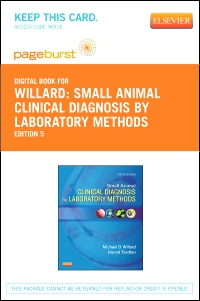
Small Animal Clinical Diagnosis by Laboratory Methods - Elsevier eBook on VitalSource (Retail Access Card), 5th Edition
Elsevier eBook on VitalSource - Access Card

A quick guide to appropriately selecting and interpreting laboratory tests, Small Animal Clinical Diagnosis by Laboratory Methods helps students learn to efficiently make accurate diagnoses. It provides answers to commonly asked questions relating to laboratory tests, and solutions to frequently encountered problems in diagnosis. For easy reference, information is provided by clinical presentation and abnormalities, and includes hundreds of tables, boxes, key points, and algorithms. This edition, now in full color, may be used as reading material for didactic classes as well as an on-the-spot, clinical reference for specific problems or conditions.
-
- Updated coverage integrates the newest advances in testing methods and diagnostic problem solving.
- NEW! Full-color photos and schematic drawings are placed adjacent to related text, and accurately depict diagnostic features on microscopic slide preparations as well as test procedures and techniques.
- Concise discussions address laboratory approaches to various disorders, possible conclusions from various test results, artifacts and errors in diagnoses, and interpretations leading to various diagnoses.
- Hundreds of tables, boxes, algorithms, and key points offer at-a-glance information including cautions, common pitfalls, and helpful "pearls," and lead to proper differential and clinical diagnostic decision making.
- Note boxes identify key considerations in correlating clinical signs with test data for accurate diagnoses, highlight safety precautions, and offer helpful tips for sample preparation and interpretation.
- Chapters on laboratory diagnostic toxicology and therapeutic drug monitoring help in handling potentially fatal poisonings and other special situations.
- Expert editors and contributors provide clinical knowledge and successful diagnostic problem-solving solutions.
- A practical appendix lists referral laboratories that may be contacted for certain diseases, and reference values with the normal or expected range for coagulation, hematology, and more.
-
- Updated coverage integrates the newest advances in testing methods and diagnostic problem solving.
- Full-color photos and schematic drawings are placed adjacent to related text, and accurately depict diagnostic features on microscopic slide preparations as well as test procedures and techniques.
-
1. General Laboratory Concepts
2. The Complete Blood Count, Bone Marrow Examination and Blood Banking: General Comments and Selected Techniques
3. Erythrocyte Disorders
4. Leukocyte Disorders
5. Hemostatic Abnormalities
6. Electrolyte and Acid-Base Disorders
7. Urinary Disorders
8. Endocrine, Metabolic, and Lipid Disorders
9. Gastrointestinal, Pancreatic, and Hepatic Disorders
10. Fluid Accumulation Disorders
11. Respiratory and Cardiac Disorders
12. Immunologic and Plasma Protein Disorders
13. Reproductive Disorders
14. Neurologic Disorders
15. Microbiology and Infectious Disease
16. Cytology of Inflammatory or Neoplastic Masses
17. Laboratory Diagnostic Toxicology
18. Therapeutic Drug Monitoring
Appendix I: Listing of Select Referral and Commercial Laboratories
Appendix II: Reference Values

 as described in our
as described in our 